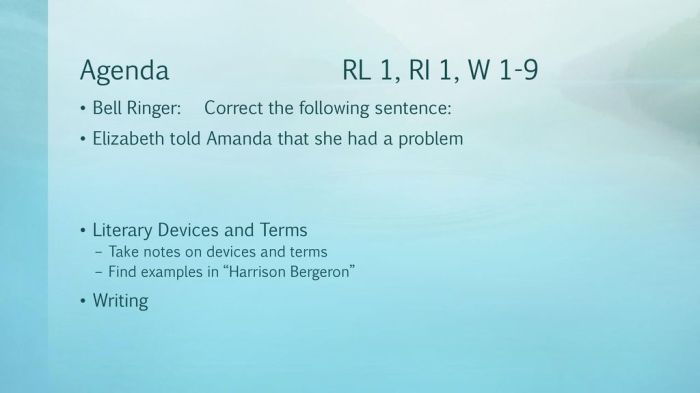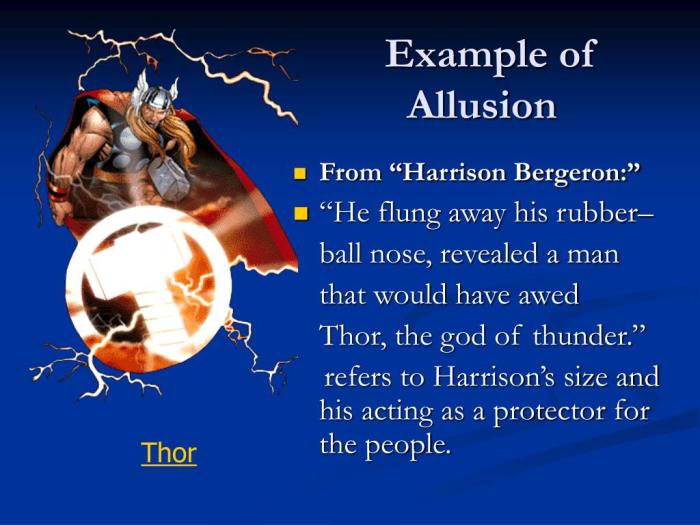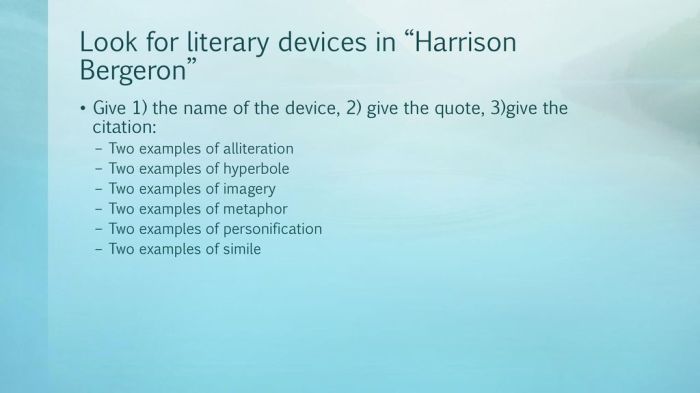Literary devices in Harrison Bergeron illuminate the complexities of Kurt Vonnegut’s dystopian masterpiece. Through symbolism, allegory, irony, satire, and figurative language, Vonnegut crafts a narrative that critiques societal norms, explores the nature of individuality, and exposes the dangers of government overreach.
The story’s rich tapestry of literary devices captivates readers, inviting them to delve into a world where conformity reigns supreme, and the pursuit of excellence is deemed a threat to the collective.
Literary Devices: Definition and Explanation: Literary Devices In Harrison Bergeron

Literary devices are techniques used by writers to create specific effects in their writing. They enhance the meaning, impact, and engagement of literary works. Literary devices include various techniques, such as metaphors, similes, imagery, symbolism, foreshadowing, irony, and satire.
Metaphors compare two unlike things without using “like” or “as,” while similes make direct comparisons using those words. Imagery appeals to the senses, creating vivid mental pictures in the reader’s mind. Symbolism uses objects, characters, or events to represent abstract ideas or concepts.
Foreshadowing hints at future events, building suspense and anticipation. Irony involves a contrast between what is expected and what actually occurs, creating a sense of surprise or humor. Satire uses humor, wit, and exaggeration to criticize or expose societal flaws or human folly.
Literary Devices in “Harrison Bergeron”

Kurt Vonnegut’s short story “Harrison Bergeron” employs a range of literary devices to convey its themes and critique of society. These devices include symbolism, allegory, irony, satire, and figurative language.
Symbolism is evident in the Handicapper General’s physical and mental handicaps, representing the oppressive forces that stifle individuality and freedom. The story’s setting, a dystopian future where equality is enforced through artificial means, serves as an allegory for the dangers of totalitarianism and the suppression of human potential.
Irony and Satire in “Harrison Bergeron”, Literary devices in harrison bergeron
Irony is employed in the story to highlight the absurdity and contradictions of the dystopian society. The government’s goal of creating equality through handicaps ironically leads to further inequality and injustice.
Satire is used to criticize the oppressive nature of the government and the dangers of conformity. Vonnegut satirizes the idea of a society where everyone is forced to be the same, regardless of their abilities or desires.
Figurative Language in “Harrison Bergeron”
Vonnegut uses various types of figurative language in “Harrison Bergeron” to enhance the story’s imagery and emotional impact. Metaphors, such as comparing the Handicapper General’s voice to “a rasping saw,” create vivid mental pictures.
Similes, such as describing Harrison’s strength as “the strength of a bull,” make comparisons that emphasize the character’s extraordinary abilities. Personification, such as giving human qualities to the handicaps, adds depth and complexity to the story’s characters and themes.
Detailed FAQs
What is the significance of the Handicapper General in Harrison Bergeron?
The Handicapper General represents the oppressive force of the government, ensuring that everyone remains equal and compliant. Their actions symbolize the suppression of individuality and the erosion of personal freedoms.
How does Vonnegut use irony to critique society in Harrison Bergeron?
Vonnegut employs irony to highlight the absurdity of the government’s policies. The Handicapper General’s efforts to create equality ironically result in further inequality, as those with natural advantages are punished for their abilities.

